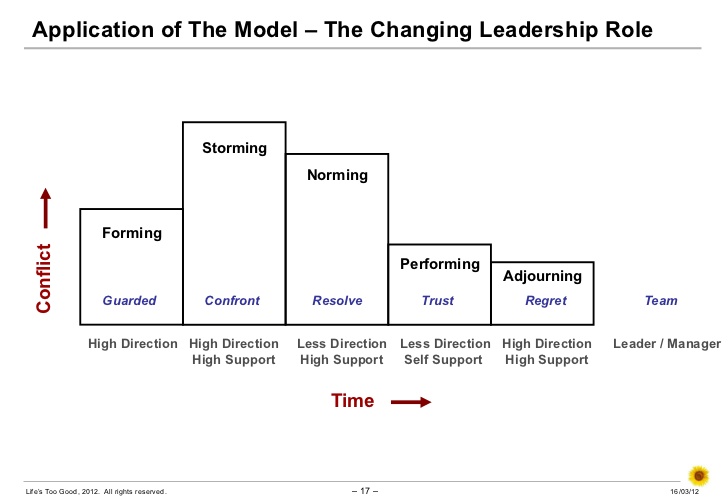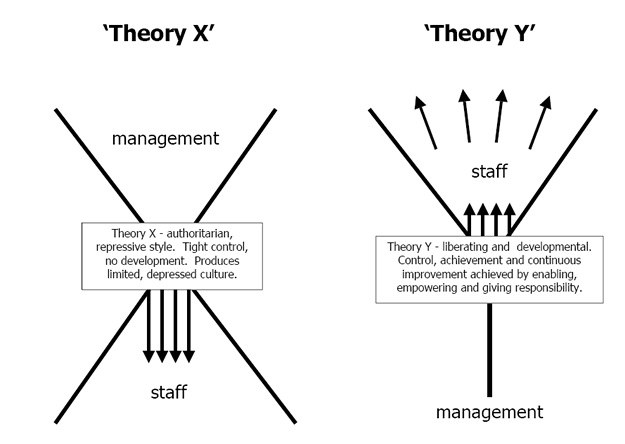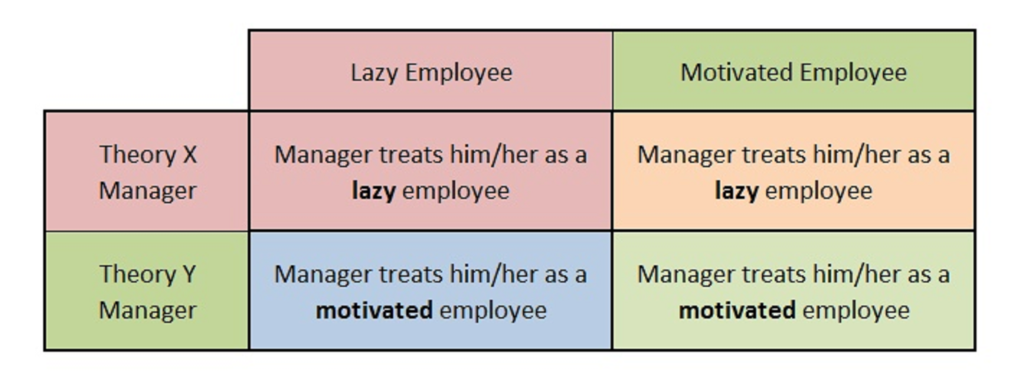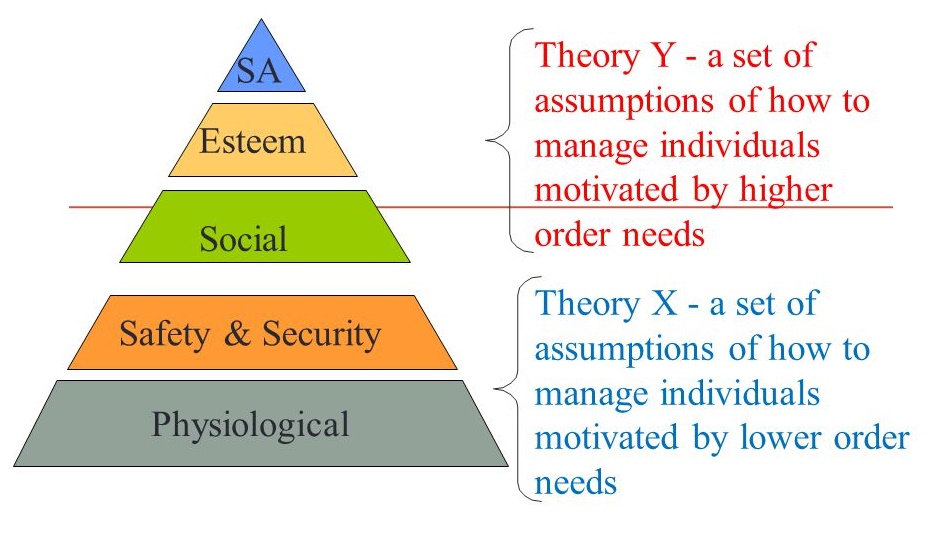Theory X and Theory Y: Understanding People’s Motivations (According to McGregors Theory)

Are you someone who believes people generally work because they gain satisfaction from their employment?
… or …
Do you believe in general that people only work because they have to – in order to earn money and make a living?
Understanding Theory X and Theory Y
You may have already heard of Mcgregors Theory X and Theory Y model of human motivation and management. It is a very basic model and often the world is more complex. For example your answer to the above question may very well be that it depends upon what kind of job they have, or even what kind of person they are… and you’d be right to raise these points.
Often though, simple models such as this one can be useful as a frame of reference and as a starting point for further discussion.
So what exactly did Mcgregor describe in his model?
In his theory, McGregor proposed that every manager has a personal view about what motivates people, and that these views affect what managers do and how they behave, i.e. their management style.
He described two opposing viewpoints: Theory X, whereby a manager believes that in general his/her worforce are lazy, not inherently motivated to work and do so only because they have to (motivated only by rewards such as money or the avoidance of punishment) and Theory Y whereby a manager believes that his/her workforce want to work, to contribute, participate and strive to achieve.
These beliefs would clearly influence a manager’s style. The manager’s style, in turn, is highly likely to have an effect on the productivity of the workforce and the culture within a given organisation.
Now let’s look at each opposing viewpoint in a little more detail.
Theory X
A manager with a Theory X viewpoint generally mistrusts his/her workforce.
He/she believes that the typical employee has little to no ambition, is lazy and workshy, avoids responsibility and if goal oriented at all is more individually goal-oriented rather than being a team player or interested in the overall success of the organisation.
Theory X managers tend to believe that they are superior to their workers, that their workers need to be looked after or micro-managed and are much more task oriented. They are likely to very deliberately assign individual responsibility for such tasks so that success or failure to perform certain tasks and actions can be easily traced back to the individual concerned who can then be given a direct reward or punishment according to their performance. They believe workers need to be prompted, rewarded or punished constantly to ensure they complete their assigned tasks.
a Theory X Manager typically believes their staff:
- dislike their work / are lazy
- cannot be trusted
- need to be closely supervised / micro-managed
- dislike or avoid responsibility
- have no inherent incentive or desire to work
- lack ambition
- work only for pay or because they have to
- have to be driven by rewards or punishment
This style of management can work in situations where the nature of the work, the working environment or the working conditions are such that staff are not intrinsically motivated to perform.
Motivators under Theory X can be said to be external and effectively a system needs to be put in place incorporating these external motivators due to the mistrust inherent in the Theory X approach.
Though Theory X is a more firm managerial approach, McGregor describes both Theories X & Y as not two ends of a scale, but as each having a scale themselves.
At one end of the scale, a “hard” Theory X involves tight supervision with authoritarian management pushing employees toward desired outcomes, with immediate reward or punishment and perhaps some degree of intimidation.
At the other end of the scale, a “soft” Theory X involves workers being motivated by the absence of supervision or punishment. We are still talking about Theory X here so the beliefs are still as above, i.e. mistrusting the workforce, but the soft approach carries the hope that leniency and less strictly regulated rules will lead to higher workplace morale and more cooperative employees.
Theory X though it may sound harsh, particularly in the modern world, can prove to be effective in terms of consistency of work. When things are so tightly controlled, they tend to yield more predicatble outcomes. This comes at a cost though.
Repetitive or specialist industries with a high degree of categorisation between individuals roles or tasks can be appropriate environments for a Theory X approach to be effective allowing a company to mass-produce more quantity and a predictable higher quality which in turn results in higher profits, however due to the lack of trust, exceeding of expectations is unlikely.
Finally it goes without saying that whenever such a model talks of both ends of a scale, at either end is the extreme with real-world application being more likely to be somewhere between these two extremes.
Theory Y
A manager with a Theory Y viewpoint generally trusts his/her workforce.
He/she believes that the typical employee is internally motivated, enjoy their work, and work to better themselves without needing a direct “reward” in return. Theory Y workers are highly valued, believed to be assets to the company and contribute to the success of the organisation.
Theory Y is pretty much the exact opposite to Theory X, with the main factor between the two being trust.
When that trust is absent as shown above for Theory X, a system is needed with external motivators to cope with that situation. In Theory Y this is unnecessary.
In Theory Y, a more decentralised approach to workload is possible with management keen to empower their staff and the possibilities of an organisation getting the most out of their people in a creative, forward thinking environment. This is not without it’s own challenges, which we’ll come to.
a Theory Y Manager typically believes their staff:
- enjoys or wants to enjoy their work
- can be trusted
- do not need to be closely supervised and are self-motivated
- want more responsibility
- have inherent incentive or desire to work
- have ambition and are keen to be challenged
- view work as fulfilling or challenging
- are happy to work on their own initiative
- like to be creative and solve problems
In a Theory Y organisation, responsibility for the success of the organisation is more shared rather than being a burden of management alone as in Theory X. Staff are listened to and trusted with as much responsibility as they can handle. Open communication is encouraged, there is no such thing as a bad idea or stupid question.
Relationships are more personal and managers are more likely to be friends with their staff. There is more likely to be a healthier atmosphere in the workplace. Creative companies actively encourage this creativity and communication with open, shared workspaces, ‘chill-out’ areas and increasing on-site facilities and convenience for workers as well as more flexible work arrangements (which require the trust that comes with Theory Y).
Theory Y works well in research, academic and creative environments but is also being embraced by most modern companies, even in those more traditionally associated with Theory X.
Like Theory X, Theory Y is a scale in itself, with the level of trust and empowerment being something that a company can have more or less of depending upon their approach.
So Theory Y is the winner, right?
Well, not always. It does have some risks and potential difficulties as an approach and if not tempered to the organisation and situation. First of all, whilst there is potentially a better, more personable and more trusting atmosphere in a Theory Y organisation, there is more room for error from a QA perspective, i.e. in terms of consistency and uniformity. Also, if not understood and implemented correctly, then Theory Y can lead to weak management, a lack of control and potentially workers taking advantage of the trust, becoming demotivated due to lack of support from management or undermining their management.
If a manager is too hands off and individuals given too much autonomy, it can be easy to lose alignment, as different individuals go in different tactical directions.
Effective Theory Y management involves first establishing that the environment is one where there is sufficient trust and also making sure that empowerment is genuine empowerment and not over-work or giving people responsibility or tasks they can’t handle. All of this is possible with good communication and feedback mechanisms which should be part of any successful organisation or management style.
This is quite a popular diagram depicting the difference between the two theories:
Combining The Manager’s Viewpoint with Workers Motivation
Of course there is more than one actor in this scenario. McGregor’s Theory is concerned with the viewpoint of the manager and how that then relates to their management style and the motivation (or lack of) of their workforce.
But what of the workers?
What if a Theory X manager believes their workforce are a bunch of workshy buffoons but some of said workforce are more aptly described by Theory Y?
(in reality that manager will likely have a mixture as, if you haven’t guessed by now, Theory X and Theory Y are at either end of a scale with some workers being more motivated to work than others and perhaps also in reality for various reasons and to various degrees given the nature of the work)
i.e. what if the manager is dead wrong about some of his workforce who are actually very motivated to work for work satisfaction alone and are actually very trustworthy?
Well, because McGregor’s theory describes an overall viewpoint and relates to the workforce as a whole rather than individuals, which in turn drives a management style, the answer is that the manager won’t trust them anyway and will assume these motivated individuals to be lazy just like all the rest of the workers.
At best because we are concerned with an approach and management style, then that manager would still need some convincing and certainly more convincing than a Theory Y type manager were he to get down to looking at an individual worker.
So we have the following 2×2 Matrix of possibilities:
Looking at these combinations, we can imagine a few scenarios and also ask a few questions. First of all is it right to treat a lazy employee through the eyes of Theory X manager (top left, red quadrant)? Not necessarily. As managers we are bound to run into lazy employees, but as I said above, usually a workforce will consist of a mix of both types of employees, or more specifically a mix of people at different points on a scale somewhere between the two extremes.
Showing clear distrust and micromanaging of lazy employees may have a knock-on effect on motivated employees and affect the working environment and culture of the organisation. I believe we have moved on from Theory X in most sectors and most managers would now believe that the best managers and leaders out there inspire their workforce through communication, shared vision and values and empower their employees as much as possible (i.e. are more Theory Y). The manager may even succeed to change the nature of the employee working under him.
Caveat: As I’ve said earlier there is a time and place for micromanagement and a Theory X approach but even McGregor in putting forward his Theory X and Theory Y model favoured a movement toward Theory Y and away from X.
The 2nd category (bottom-left, blue quadrant) could show where a Manager works with a group of lazy employees to bring a project to success. It could equally describe a scenario where the Theory Y manager is too trusting and too empowering and where workers are not to be trusted, the manager loses control of his staff.
Category 3 (top right, orange quadrant) is most likely a story of under-utilization of resources. A Theory X manager failing to get the best out of his employees and most likely demotivating otherwise trustworthy and valuable employees.
As with most 2×2 matrices, there is a best of both worlds – in this case the Theory Y manager coupled with the Theory Y workers (bottom right, green quadrant). The manager recognising the employees motivation and value will reap the rewards of a workforce he can trust and delegate work to, safe in the knowledge that the workforce, within reason should rise to the challenge.
Relating McGregors Model to Maslow’s Hierarchy of Needs
Another very useful model I’ve covered in a previous article is Maslow’s Hierarchy of Needs. Maslow described a hierarchy of needs which must be met in sequence to address any deficiencies (1st 4 levels, what he also referred to as ‘d-needs’) before addressing the final 5th level need of Self-Actualisation (which he also referred to as a ‘being need’ or ‘b-need’).
McGregors Theory can be related to Maslow’s Hierarchy of Needs as follows:
as, if we believe that workers generally dislike work and only work because they have to, then they are clearly not doing so for Self-Actualisation purposes.
Forming, Storming, Norming & Performing
Another model which I think can be discussed in relation to Theory X & Theory Y is the Forming, Storming, Norming & Performing model of team dynamics.
I’ve written quite extensively on this theory here: The “Forming, Storming, Norming, Performing” Business Model
Here is one of the slides from the presentation in that article which shows how attitudes of the team and the manager relate over the various stages of the teams development.

The Forming, Storming… model describes that there are inevitable stages of maneouvering, discovery & mutual understanding that teams must go through before they are able to perform (i.e the Forming, Storming & Norming phases). Sometimes these stages are quick and painless and sometimes they are more challenging.
So how does a manager’s style on the Theory X/Theory Y scale affect the teams progression through these stages?
You might think that showing trust in your team would help with the team’s progression but that doesn’t necessarily follow in all cases. In the ‘Storming’ phase of team development conflicts can arise for many reasons, one of these being rivals fighting for position in an assumed hierarchy. In this case, perhaps a more ‘Theory X’ approach is warranted. It all depends upon the scenario in question.
Some Personal Experiences Relating to Theory X & Theory Y
So I would definitely say that over the years in the various managerial roles I have had that I have been more of a Theory Y manager than Theory X, but it hasn’t always been plain sailing.
You may think reading the above and also given McGregors own views on his theory that Theory Y is clearly the way to go, but it’s not always that straight-forward.
Example 1: First Managerial Roles
When I first started getting into management, it was in an environmnt where I had been working for some time and ended up managing people I’d been working with for some time and got along well with, or at least in an organisation where I’d managed to develop a decent track record and reputation. In this case, the Theory Y approach definitely worked very well – I was working with staff that wanted me to do well and vice versa and the trust was definitely there on both sides. I’d class these as performing teams.
I mentioned above that I’d class these as performing teams. This was because there was very little in the way of ‘storming’ as in these cases forming the teams with myself in a more managerial position was a relatively small change, the staff already knew each other and knew me and everybody else’s position in the teams was generally quite established. It’s worth noting that this isn’t always the case – it’s entirely possible that the introduction of one new role or member to a team or even a small change to a single individual’s role can cause absolute havoc. In my experiences here, because the mutual respect and trust was in place, the Theory Y approach was absolutely appropriate and supported and the teams could progress to being (highly) performing teams relatively quickly.
Example 2: More Challenging Managerial Roles
I did say it wasn’t all plain sailing and within some of the examples above there were moments when I would need to take a more Theory X approach and in some later managerial roles, when I worked for different organisations and with new teams where I couldn’t rely on existing relationships or track record there may have been longer periods where a pure Theory Y approach would have been difficult.
Often when the Theory Y approach (trust and empowerment by default) is dangerous, then something you can do as a manager is to work to create and environment where that approach does become appropriate. i.e. build the mutual trust and respect necessary for Theory Y to be at it’s most effective and learn who you can delegate what responsibility to so you can empower the right people with the right responsibilities before leaving them to sink or swim and potentially creating resentment.
Example 3: Referent Authority
I have had a couple of very senior roles in which I have had a lot of referent authority. These roles are effectively trusted advisor type roles where, whilst being in a position that is already senior, due to being the right hand man of someone in a very senior position, and acting on their behalf, their authority is implicit in a lot of actions, decisions and communications relating to the role.
In this case, though I may have adopted a more Theory Y approach to my work, with a lot of trust, empowerment etc. which that approach involves there is an interesting kind of backup from the referent authority in these roles.
In other words, though I am trusting people in these roles, they are far less likely to step out of line or undermine my authority because of my position but more specifically because of who I am working for and representing. Like an iron fist in a velvet glove.
The referential authority never needs to be mentioned or even used but it’s always there. Obviously in such roles there is still a lot of work to be done, and very senior people can be very demanding meaning that the relationship where there is no referential authority – the direct relationship with the senior sponsor is one you have to work very hard at.
It is also worth pointing out that the senior people I worked for in these roles were very successful and very well respected (well one of them was brand new so my job was to help build that success and the entire organisation along with my sponsor), if the senior sponsor is not well respected then obviously the referent authority may not actually provide any authority at all.
P.S. If you want to know more about referent authority and other types of authority, I’ve written quite a lot on different times of authority (in relation to leadership roles) here: Why You Need To Lead…
Example 4: Most Challenging Managerial Role
My most challenging role was in a new environment, with an inherited staff, failing projects, no sponsorship and the person who recruited me was sacked within three months removing the only sponsorship I did have. That as well as being mis-sold the role in the first place.
Well I do like a challenge, but admittedly taking on this role was a bad decision.
I should have seen the red flags (like during the recruiting process, the recruiting manager sending me mammoth emails at 3am).
Being a Theory Y manager in such an environment 24/7 would frankly have been impossible and as this is my preferred approach by far, I was still far more Theory Y than Theory X and it was an environment I tried to create (to facilitate more trust, entusiasm & empowerment).
Often I’ve been able to grow quite quickly in roles and take on new responsibilities (Theory Y) but due to this environment (which was very much Theory X), I was unable to do
so, which was very frustrating especially as I had had much more senior roles with experience to solve a lot of the problems my peers and superiors were facing.
Being a Theory X environment (with my management taking a Theory X approach), I was simply not allowed to help with projects outside my immediate area (because I was not trusted to and not believed when I said I could) even though I could have and was keen to, so instead I had to watch some huge mistakes being made, some really bad decisions and some huge projects (programmes) fail.
I was hugely mislead when taking this role and did actually manage to turn around all the failing projects I’d inherited, but it was a terrible environment for me to work in because I didn’t manage to build the highly performing team I wanted to, not even close.
I also had zero Expert Authority in this role which I pointed out in my interview process but was told that I didn’t need to know the subject area and that my lack of knowledge would be a bonus as I’d offer a fresh perspective (reality: at that level I absolutely did need some knowledge of the subject area, this hurt me in real terms in my work and business sponsor relationships every single day).
Expert Authority (along with Referential Authority and other types of authority) is explained in the article I referred to earlier: Why You Need to Lead…
How to Build Trust (or create a more ‘Theory Y’ environment)
Or to look at it another way, how do you transition from Theory X to Theory Y?
I’m mindful that this question is a bit of a strange one as the Theory X and Theory Y model is really more about a managers beliefs and approach to management than the environment in which he or she is working, but in reality this does permeate into the culture of an organisation and as such an organisation can effectively be more appropriately set up for either style of management.
In one of the examples above I described a Theory X environment where I struggled to use my usual more Theory Y management approach and tried instead to create an environment that would let me do that.
So if you’re a Theory Y type manager and you’re faced with a difficult situation such as this, exactly how do you go about building that trust?
Unfortunately this is a huge topic in itself and every scenario will be different but I didn’t just want to leave this puzzle unanswered at all without a few pointers, or at least exploring some of the options.
Let’s look very briefly at some problem scenarios, assuming in all of these scenarios that you are a Theory Y type manager:
- If you have a lazy worker who, no matter what you’d like to believe or happen is obviously just lazy, what do you do?
- If you have a worker who undermines your authority as a manager and questions you in meetings, then what do you do?
- If you’re in a situation as a manager where you have staff that don’t trust you and where your manager doesn’t trust you, then what do you do?
When dealing with individuals it will be about how best to deal with that individual. Is there a reason for their mistrust? Are they simply assuming you will treat them the same way as a previous manager and need reassurance? Or do they need to be taken down a peg or two because they have an over-inflated opinion of themselves? Perhaps they are after your job and you need to show them who’s boss? Perhaps they hate their work because they have been put in the wrong role and they would thrive in a different role you could easily provide them.
I could go on, but hopefully you get the point. When it’s concerning an individual (or a few individuals) you need to take that situation to one side, understand it and deal with it – but you must deal with it.
When it comes to an entire environment or organisation, it needs a more holistic approach. Again, there is not a single answer to this but we are getting into the realms of stakeholder management (that I do intend to write more on and will come back here and put a link to when I do), delivery (i.e. it is possible to influence via delivery) and perception management. To gain trust from your manager look to influence those around him/her that he/she listens to rather than him/her directly – aim for 5 key stakeholders and build really strong relationships with each of them until your manager can no longer deny your value to the organisation. When it comes to your staff you need to build trust slowly by showing you are no push-over and effecting a slow transition from the environment and management style they are used to to the one that you want. Delegate slowly so that it doesn’t look like you are doing so because you are not capable but instead is clear that you are doing so because that employee is slowly starting to earn your trust. make this clear and remove responsibility just as quickly if things aren’t working. It is a tricky transition but it can be done.
I’m not going to write a section about translating a Theory Y environment to a Theory X environment but in any case I would imagine this would be a far more straight-forward proposition as it concerns putting systems and controls in place as already alluded to in the section above on Theory X, i.e. building trust is a far more complex problem to discuss than taking it away.
Final Thought
This has ended up being quite a long article for such a simple model (ooops).
The reason for that is that simple models such as this one can actually be quite powerful and are far less rigid than more complex models.
Often a simple model is just what’s needed to make a point, support an argument or discussion or raise questions – because a picture paints a thousand words.
Models such as the Theory X and Theory Y model whilst initially seeming to be quite detached from reality do provide a frame of reference, can be a quick and easy way of examining approaches to given problems or environments and can be very effective, particularly when combined with other models.
In short, I would advise using this model as a base, or a starting point for further discussion, then hopefully you can see that though it is simple it can be very useful.
P.S. If you want more management models like this one, I’m very slowly working my way through 100 of them: 100 Management Models and When To Use Them




Nice article…in what year was it done?
Really good article.
Thanks!
This is exactly what we have learn in school, great indeed.